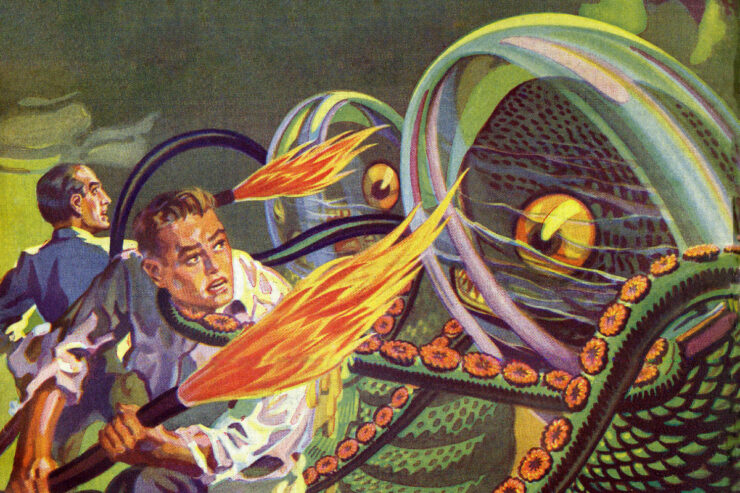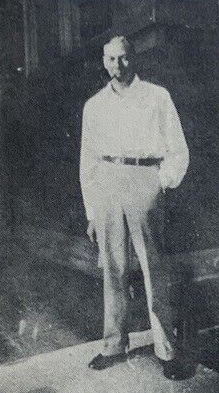 To say pulp author Paul Ernst remains a mysterious if influential hero-pulp titan is a vast understatement.
To say pulp author Paul Ernst remains a mysterious if influential hero-pulp titan is a vast understatement.
Among the countless creators toiling for the by-gone pulp magazine combines, Paul Ernst was one of the industry’s most polished prose stylists. Yet the details of his life remain stubbornly murky.
Paul’s prose prowess allowed the extremely versatile Ernst to be one of the few pulp fictioneers to smoothly transition from the drying-up pulp zines and into the slicks, in which Ernst continued to publish fiction into at least the 1970s — the same decade that Ernst’s best-known pulp series, The Avenger, enjoyed robust paperback republication and sales for Warner Books.
According to the late pulp historian Howard Hopkins, Ernst regarded The Avenger novels as his “poorest writing.” But Hopkins correctly observed that Ernst’s prose “lifted” The Avenger, representing “a quantum leap above most other pulp series.”
The Avenger series remains Ernst’s most-noted and acclaimed works of fiction.
Buckeye Beginnings
In an essay he penned for Dime Mystery Magazine, Ernst set his birth date in 1900. But other uncovered records declare Paul Frederick Ernst was born on November 7, 1899, in Akron, Ohio.
Terence C. Hanley has performed yeoman’s work teasing out the recorded and seemingly verifiable biographical facts of Ernst’s life that previously remained stubbornly unavailable.
Hanley found via Summit County, Ohio, birth records that Paul’s mother, Nellie (we’ll get back to that given name!) was widowed while Paul was still a child.
The Ernsts soon resettled in Chicago. There, Nellie married a much older man. A few years later, Paul recorded less than a year’s service with the U.S. Navy.
Pulp Writer
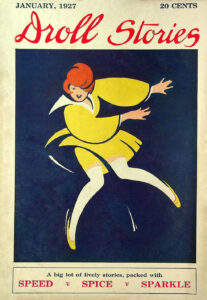 In 1926, Paul Ernst published his first recorded fiction, a vignette titled, “Lights Out” that appeared in Breezy Stories. About a year later, his first short story ran in Droll Stories.
In 1926, Paul Ernst published his first recorded fiction, a vignette titled, “Lights Out” that appeared in Breezy Stories. About a year later, his first short story ran in Droll Stories.
Remarkably prolific as only the best of classic pulp authors somehow impossibly managed to be, Paul steadily racked up a string of credits — and a long list of pseudonyms — across a wide range of pulp magazines, with seeming effortlessness, fast spanning multiple genres.
Ernest published in Amazing Stories and Astounding Stories, Horror Stories and Terror Tales, Nick Carter and The Shadow, Spicy Stories and Pep Stories, and Detective Tales and Detective Fiction Weekly, to name but a few.
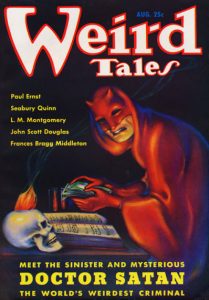 Paul Ernst also dipped his toes into the Fu Manchu-style waters, creating one of the more enduring “pulp villains” with his launch of Doctor Satan, whose eight villainous adventures unfolded between 1935 – 36 in Farnsworth Wright’s Weird Tales.
Paul Ernst also dipped his toes into the Fu Manchu-style waters, creating one of the more enduring “pulp villains” with his launch of Doctor Satan, whose eight villainous adventures unfolded between 1935 – 36 in Farnsworth Wright’s Weird Tales.
Doctor Satan’s recurring heroic “antagonist” was Ascott Keane, a kind of playboy cum occult detective . . . think a 1930s vintage version of Marvel Comics’ Doctor Stephen Strange.
While Doctor Satan’s secret identity is never revealed, it’s hinted that the villain is also a rich but bored and debauched ne’er-do-well cut from Stephen Strange-style’s now somewhat cliched cloth, but sinisterly swamped by existential ennui driving him to don a red cloak, red mask, and horned crimson skullcap, embracing a life of science-plus-mystic-arts fused crime.
The Avenger
In 1939, Ernst launched the character that would earn him an enduring place in the “Hero Pulp Fiction Hall of Fame.”
Street & Smith was once again looking to duplicate the success of its twice-monthly published Shadow and monthly Doc Savage hero pulps. Years before, the S&S honchos had flirted with also taking Doc Savage to twice-monthly publication but changed course.
In 1939, it was decided a new S&S hero pulp title would launch, one heralding a kind of hybrid or fusion of the Doc Savage and Shadow title characters, in the person of tycoon/adventurer Richard Henry Benson, AKA, The Avenger. Street & Smith’s circulation manager Henry William Ralston and editor John L. Nanovic signed Paul Ernst to write the series.
Reportedly, The Shadow’s Walter B. Gibson (AKA Shadow raconteur “Maxwell Grant) and Lester Dent (AKA, “Kenneth Robeson”) counseled Ernst on the hero-pulp-writing “rules of the road.”
Leaning harder toward Doc than The Shadow in terms of vibes and characterization, Ernst’s ensuing two-dozen Avenger novels featured a title hero surrounded by a team of aides much like Doc Savage’s “Fantastic Five.” The Avenger novels also shared the byline of Kenneth Robeson (“Creator of Doc Savage”).
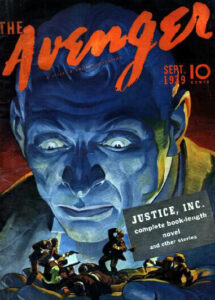 But there were also characteristics that distinguished The Avenger and his arc of novels from the far longer, greater runs of The Man of Bronze and The Master of Darkness.
But there were also characteristics that distinguished The Avenger and his arc of novels from the far longer, greater runs of The Man of Bronze and The Master of Darkness.
Unlike those of Doc Savage and The Shadow, as noted, all of the original, novel-length Avenger pulp tales were exclusively penned by a single author — Ernst.
Ernst’s novels also build in a chronological fashion that has resulted in 20th-century and 21st-century reprints of all of his Avenger novels in their original publication order, rather than jumping around as all sanctioned Doc Savage and Shadow paperback reprints have subsequently done.
Thanks again to Terence C. Hanley’s digging into Ernst’s buried biographical details, we can also see how the enigmatic Ernst’s life informed Avenger lore.
Richard Benson’s backstory, the trigger that transforms him into a career vigilante, is among the most tragic of the great pulp heroes’ origin stories.
We never really learn what drives the Kent Allard/Lamont Cranston/Shadow in the pulps, although subsequent films and comics have tried to retcon some explanations.
Doc Savage’s father’s murder launches The Man of Bronze into what mythologist Joseph Campbell would term Doc’s “full career” as a crime fighter. But as a child, Doc had already been set on the eventual path of trouble-shooting by his unstable father for reasons maybe or maybe not related to the death of Doc’s mother years before — a mother Doc was simply too young to remember.
In hardcore noir fashion, the first Avenger novel, “Justice, Inc.,” begins with Benson’s wife and daughter being mercilessly pitched midflight from a plane by criminals after wealthy Benson has bulled his family passage onto the ill-fated flight, literally placing his family in fatal harm’s way.
The guilt-ridden Benson, like Nellie (Ticknor) Ernst, was — unlike The Shadow, Doc Savage, or Richard Wentworth, a widower.
Over the course of his first several adventures, Richard Benson gathers to himself a growing team of agents.
In the second novel, “The Yellow Hoard,” the team’s third agent joins Justice, Inc. This is also the team’s first female agent, the attractive and diminutive Nellie Gray.
The Avenger series is particularly striking for its forward-leaning diversity, including not just Nellie as an official agent — a status Doc Savage’s cousin Patricia Savage, for instance, never achieved — but also a married couple of color, Josh and Rosabel Newton. The Newtons were introduced in the series’ third issue, featuring the Ernst story “The Sky Walker.”
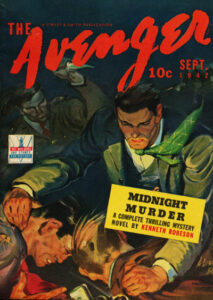 Oftentimes, authors are accused of ego projection in shaping their heroes. However, other than a penchant for prestidigitation, Walter B. Gibson and The Shadow reflect little obvious intersection.
Oftentimes, authors are accused of ego projection in shaping their heroes. However, other than a penchant for prestidigitation, Walter B. Gibson and The Shadow reflect little obvious intersection.
Lester Dent supposedly stood about six-two and had a zeal for gadgets. Eventual “Science Detective” and gadgeteer Doc Savage stood about six feet tall in his first adventure, although he may have grown to six feet, seven inches or better in later adventures.
As pulp heroes go, Dick Benson — nicknamed “The Man of Steel” before Superman — was incredibly strong, but rather height-challenged in comparison to his lanky peers, coming in at something under six feet tall. Because of Hanley’s research, we now know Ernst’s 1942 draft card puts Paul’s frame at five feet, ten inches and weighing just 140 pounds.
Paperback Rebirth
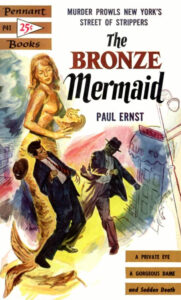 Following his run on The Avenger, Paul Ernst increasingly turned to the so-called slicks for his bread and butter. Although an occasional yarn would turn up in detective pulps, Short Stories, or Weird Tales from time to time, between late 1942 and the early seventies, the Ernst byline can generally be found in such mass-market magazines as The American Magazine, Collier’s, The Country Gentleman, Family Circle, Good Housekeeping, Liberty, McCall’s, The Saturday Evening Post, Woman’s Home Companion, and most particularly in Redbook. He also published a number of mystery novels during the 1950s, including The Bronze Mermaid, Hangman’s Hat, Lady, Get Your Gun, and Short of Murder.
Following his run on The Avenger, Paul Ernst increasingly turned to the so-called slicks for his bread and butter. Although an occasional yarn would turn up in detective pulps, Short Stories, or Weird Tales from time to time, between late 1942 and the early seventies, the Ernst byline can generally be found in such mass-market magazines as The American Magazine, Collier’s, The Country Gentleman, Family Circle, Good Housekeeping, Liberty, McCall’s, The Saturday Evening Post, Woman’s Home Companion, and most particularly in Redbook. He also published a number of mystery novels during the 1950s, including The Bronze Mermaid, Hangman’s Hat, Lady, Get Your Gun, and Short of Murder.
In 1972, Warner Paperback Library began republishing The Avenger under the Kenneth Robeson byline.
As a pre-teen reader, even then, I could detect a sharp difference in literary quality. Not yet aware that Kenneth Robeson was a “house name,” I felt Robeson brought his A-Game to The Avenger but tended to be a fast-and-loose storyteller when he shifted to penning Doc Savage.
Ernst’s Avenger novels gripped me in ways concurrent Doc Savage and Shadow paperback reprints did not. As an author, Ernst is much more polished and pace-assured than Dent or Gibson.
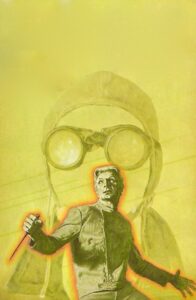 Indeed, and as earlier noted, the quality and enduring appeal of Ernst’s Avenger novels have contributed to their complete republication not once, but twice. While Doc Savage has also managed this republication feat, few others of the truly enduring great pulp heroes have achieved this rare status, including The Shadow, whose grand Sanctum reprint run fell a few novellas shy of republishing all of the Dark Avenger’s original pulp tales.
Indeed, and as earlier noted, the quality and enduring appeal of Ernst’s Avenger novels have contributed to their complete republication not once, but twice. While Doc Savage has also managed this republication feat, few others of the truly enduring great pulp heroes have achieved this rare status, including The Shadow, whose grand Sanctum reprint run fell a few novellas shy of republishing all of the Dark Avenger’s original pulp tales.
In a further testimony to the power of Ernst’s Avenger saga, it is worth noting the character also set a record for the most authorized and corporately published, mass distribution paperback continuations of any legacy pulp character, via the Warner run. Having exhausted the original two-dozen pulp tales, Warner contracted with author Ron Goulart to pen a dozen fresh Avenger novels, concluding with “Demon Island,” published in May 1975.
Although the shift in writing and story-telling was jarring and ultimately inferior to Ernst’s, Goulart nevertheless extended the Condé Nast-sanctioned Warner run of Avenger stories by nearly a third of their original pulp magazine run, a feat likely forever to elude Doc Savage, The Shadow, or The Spider.
In the 1970s, Paul Ernst was living in Florida, where he died on September 21, 1985. Characteristically, there is some ambiguity about the precise Sunshine State city in which he died. Thankfully, he lived long enough to see all of the Warner reprints, as well as a DC comic book adaptation including short takes on his novels Justice, Inc. and The Sky Walker.
What Ernst made of all this, like so much of his life, remains something of a tantalizing question 125 years after his birth.
The image of Paul Ernst is from the September 1936 issue of Fantasy Magazine, edited by Julius Schwartz. An early science fiction fanzine, it was founded in 1932 as Science Fiction Digest. It published original fiction, articles, reviews, gossip, and biographical pieces and is most noted for the round-robin story, “The Challenge from Beyond.”
Paul Ernst was one of the leading writers for Clayton’s Astounding Stories of Super-Science, and later, Street & Smith’s Astounding Stories. Between 1930 and 1935, Ernst contributed ten science fiction stories and short novels to the magazines, plus a pair of stories to Clayton’s Strange Tales of Mystery and Terror. Our featured image is Hans Wessolowski’s cover art for the September 1930 issue of Astounding Stories of Super-Science, illustrating Ernst’s novella “Marooned Under the Sea.”
Although he got his start with a vignette in Breezy Stories, Paul Ernst’s first published story appeared in the January 1927 issue of C. H. Young’s Droll Stories, with cover art by Ethel Plummer.
Ernst’s first Doctor Satan story ran in the August 1935 Weird Tales, with cover art by Margaret Brundage. Competing for newsstand space with such weird-menace titles as Horror Stories and Terror Tales, the Satan stories were added to keep readers of “The Unique Magazine” from drifting over to the shudder pulps.
Of course, Paul Ernst is best known as the author of The Avenger novels for Street & Smith’s hero pulp of the same name. The Avenger was yet another attempt by the venerable pulp magazine publisher to cash in on the hero-pulp genre that they had started with the debut of The Shadow, a Detective Magazine in 1931. Pictured above are the covers for the first issue of The Avenger — dated September 1939 and featuring cover art by H. Winfield Scott — and the final issue of the series, dated September 1942 and featuring cover art by A. Leslie Ross.
During the 1950s, Ernst published several mystery novels, including The Bronze Mermaid, a private-eye yarn originally published in 1952 by M. S. Mill Co. and William Morrow. Pictured here is the 1954 reprint from Pennant Books, with cover art by Mitchell Hooks.
Ernst’s work on The Avenger was particularly forward-leaning as the author introduced both a woman as an official agent and a couple of color. Josh and Rosabel Newton were introduced in “The Sky Walker,” the third novel in the series, originally published in the November 1939 issue of the pulp magazine. The story was later reprinted as the third book in the Warner Paperback Library series — published in August 1972 — with original cover art by Peter Caras.
To learn more about the Avenger, please visit the PulpFest YouTube channel at https://www.youtube.com/@pulpfest for Craig McDonald’s Avenger film at https://youtu.be/D02CNWm2rfg. While you’re there, you can also catch Craig’s latest film on yet another Street & Smith pulp hero, The Whisperer — The Long Arm of Justice. It was released on November 5, 2023.
Both films are part of PulpFest’s popular series exploring the “The Great Pulp Heroes,” produced and created by Craig McDonald, author of the popular Adventures of Zana O’Savin series from Night Time Books.

